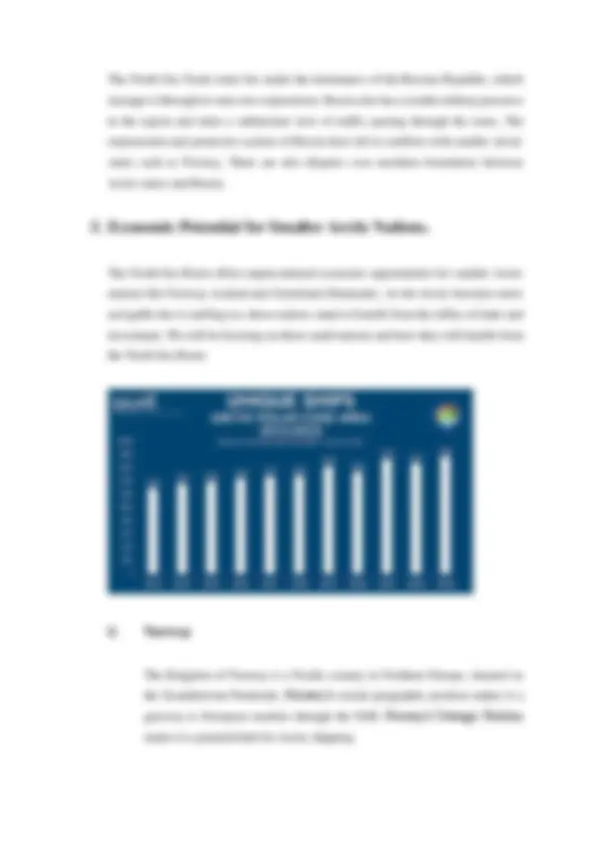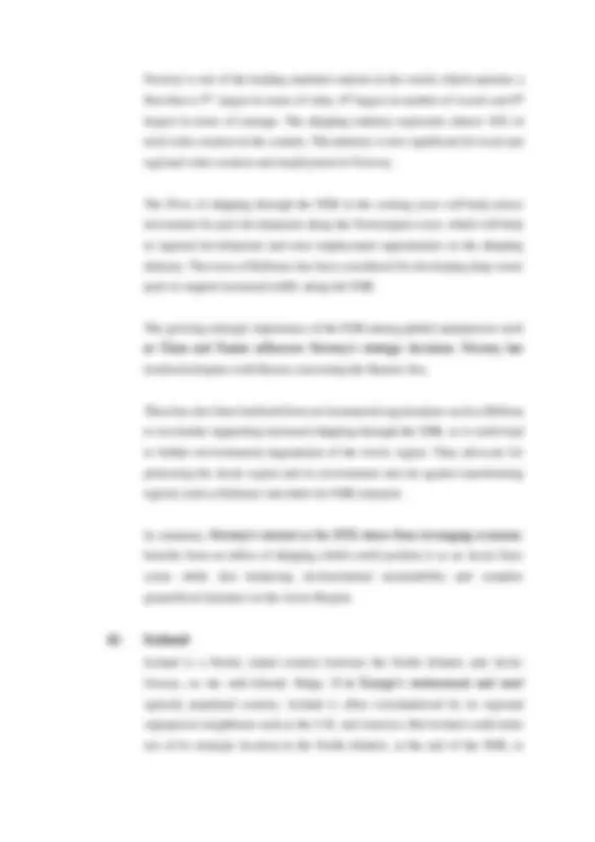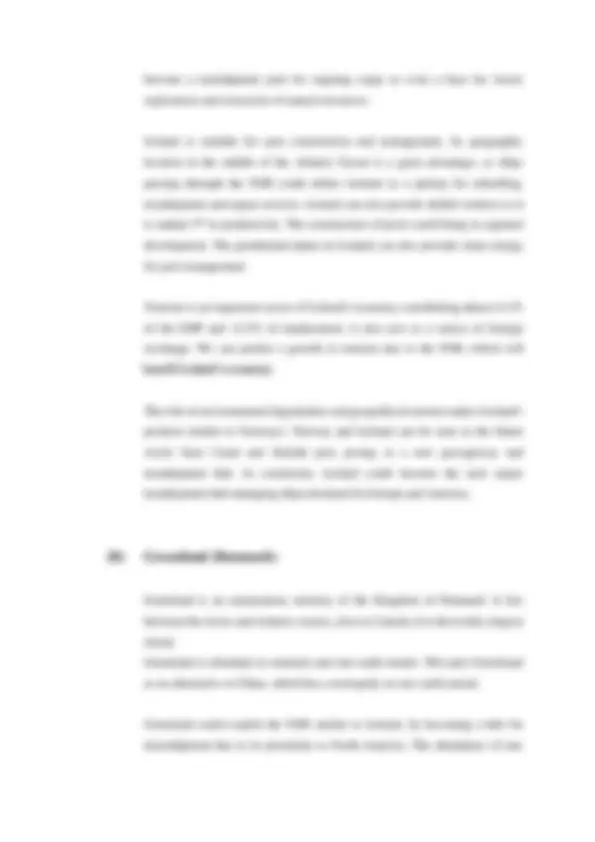







Study with the several resources on Docsity

Earn points by helping other students or get them with a premium plan


Prepare for your exams
Study with the several resources on Docsity

Earn points to download
Earn points by helping other students or get them with a premium plan
Community
Ask the community for help and clear up your study doubts
Discover the best universities in your country according to Docsity users
Free resources
Download our free guides on studying techniques, anxiety management strategies, and thesis advice from Docsity tutors
This research paper explores the potential economic benefits and challenges of the north sea route (nsr) for smaller arctic nations like norway, iceland, and greenland. It examines how the nsr could transform their economies through increased shipping, resource development, and tourism, while also highlighting the risks associated with environmental degradation, geopolitical tensions, and dependence on larger powers. The paper provides a comprehensive analysis of the nsr's impact on these nations, emphasizing the need for sustainable development and careful consideration of the potential risks.
Typology: Essays (university)
1 / 9

This page cannot be seen from the preview
Don't miss anything!






The opening of the North Sea Route due to climate change presents both opportunities and challenges for small arctic nations. The North Sea route is an alternative to the Suez Canal and provides many benefits such as increased shipping, resource development, Tourism and investment for infrastructure development. This research aims to assess the impacts of the NSR on smaller Arctic nations that are ignored when discussing the Arctic. The research will dive into the opportunities and challenges, and inform policy decisions that promote sustainable development and mitigate potential risk.
Imagine a future where the vast, desolate, and harsh Arctic region becomes a bustling corridor for global trade. The Northern Sea Route (NSR) is a potential shortcut that connects the Atlantic and Pacific oceans through the Arctic Ocean. It is about 5, kilometres long, starting at the Kara Strait and ending at the Bering Strait. The route passes through Russia, Japan, and Norway. The reduction in ice coverage in the Arctic due to global warming has led to an increase in shipping traffic through the North Sea Route, which is the shortest route between the Asia–Pacific region. This has led to the region becoming a focal point for global powers. But beyond the geopolitical giants that dominate the Arctic region, lies a group
of smaller nations – Norway, Iceland, Greenland – whose economic futures are linked to the shifting waters of the Arctic. The North Sea route could offer these small Arctic Nations a transformative role in the global economy, allowing them to diversify their trade routes, foster economic growth and bolster their geopolitical influence. These nations could capitalise on the NSR to not only reshape their economies but also to shift the dynamics of global trade. This article explores how the North Sea Route could become an economic advantage for smaller Arctic nations. We will cover everything from the potential for infrastructure development to the challenges posed by environmental risk and examine how these nations can harness the power of the NSR to pave the way for a prosperous Arctic.
The North Sea Route is situated in the Artic Region. The route starts from the Kara Strait, which is the boundary between the Barents and Kara Sea. It ends in the Bearing Strait, at Cape Dezhnev. The NSR is a part of the Northeast Passage, which is similar to the Northwest Passage in Canada. The Entire route lies within Russia’s exclusive economic zone (EEZ). Rosatom is a Russian state-run corporation that organizes the navigation of the vessels operating in the NSR. Russia is a main player in the region along with China, India, Japan and South Korea. Beijing views the NSR as a new route that will not only reduce shipping costs but also reduce China’s dependence on the Strait of Malacca. China has already started pouring in Investments through its Belt and Road initiative. India’s interest in the NSR hinges on developing the Chennai – Vladivostok eastern maritime corridor, which will reduce shipping costs and travel time. The NSR is geopolitically significant as it can change the dynamics of global trade, provide access to abundant natural resources in the Arctic and serve as a strategic advantage to nations such as Russia and China.
Norway is one of the leading maritime nations in the world, which operates a fleet that is 5th^ largest in terms of value, 6th^ largest in number of vessels and 8th largest in terms of tonnage. The shipping industry represents almost 10% of total value creation in the country. The industry is also significant for local and regional value creation and employment in Norway. The Flow of shipping through the NSR in the coming years will help attract investment for port development along the Noweregien coast, which will help in regional development and raise employment opportunities in the shipping industry. The town of Kirkenes has been considered for developing deep-water ports to support increased traffic along the NSR. The growing strategic importance of the NSR among global superpowers such as China and Russia influences Norway’s strategic decisions. Norway has territorial disputes with Russia concerning the Barents Sea. There has also been backlash from environmental organisations such as Bellona to reconsider supporting increased shipping through the NSR, as it could lead to further environmental degradation of the Arctic region. They advocate for protecting the Arctic region and its environment and are against transforming regions such as Kirkenes into hubs for NSR transport. In summary, Norway’s interest in the NSR stems from leveraging economic benefits from an influx of shipping which could position it as an Arctic Suez canal, while also balancing environmental sustainability and complex geopolitical dynamics in the Arctic Region.
Iceland is a Nordic island country between the North Atlantic and Arctic Oceans, on the mid-Atlantic Ridge. It is Europe’s westernmost and most sparsely populated country. Iceland is often overshadowed by its regional superpower neighbours such as the U.K. and America. But Iceland could make use of its strategic location in the North-Atlantic, at the end of the NSR, to
become a transhipment port for ongoing cargo or even a base for Arctic exploration and extraction of natural resources. Iceland is suitable for port construction and management. Its geographic location in the middle of the Atlantic Ocean is a great advantage, as ships passing through the NSR could utilize Iceland as a pitstop for refuelling, transhipment and repair services. Iceland can also provide skilled workers as it is ranked 3rd^ in productivity. The construction of ports could bring in regional development. The geothermal plants in Iceland can also provide clean energy for port management. Tourism is an important sector of Iceland's economy contributing almost 6.1% of the GDP and 12.5% of employment, it also acts as a source of foreign exchange. We can predict a growth in tourism due to the NSR, which will benefit Iceland’s economy. The risk of environmental degradation and geopolitical tension makes Iceland's position similar to Norway's. Norway and Iceland can be seen as the future Arctic Suez Canal and Salalah port, posing as a new passageway and transhipment hub. In conclusion, Iceland could become the next major transhipment hub managing ships destined for Europe and America.
Greenland is an autonomous territory of the Kingdom of Denmark. It lies between the Arctic and Atlantic oceans, close to Canada. It is the world;s largest island. Greenland is abundant in minerals and rare earth metals. This puts Greenland as an alternative to China, which has a monopoly on rare earth metals. Greenland could exploit the NSR similar to Iceland, by becoming a hub for transshipment due to its proximity to North America. The abundance of rare
The loss of the environment and deteriorating climate conditions due to global warming can be a major risk attributed to the growth of the NSR. The melting of the polar ice caps and rising sea levels in smaller arctic countries must be taken into account while looking at the economic potential of the NSR. The lack of proper infrastructure to manage shipping is another problem. The smaller arctic countries do not currently have the proper set-up to manage the large flight of ships coming through the NSR. The construction of infrastructure will require massive investment. The geopolitical race for the Arctic will invite superpowers such as Russia, China and America, who will use smaller Arctic nations as pawns in their game to take control of the Arctic. The NSR will make the Arctic into a new Middle East. Norway will be used as a naval base to thwart Russia's advances, and Iceland and Greenland will be used as transhipment hubs and bases for natural resource extraction from the Arctic.
The North Sea Route presents a significant economic opportunity for global trade, but its implications for smaller arctic nations are multifaceted. Economically these nations stand to gain from increased trade and investment. However, these prospects are tempered by challenges such as costly infrastructure development, increased competition for arctic resources and dependence on larger powers. The risk of environmental degradation is also concerning. The NSR poses significant risks that include increased pollution, disruption to fragile ecosystems, and the acceleration of climate change. The warming of the Arctic could cause sea level rise in these small nations and deprive them of their natural resources such as fish.
Ultimately, the NCR's impact on these nations will depend on their ability to balance sustainability and economic development. The geopolitical resilience against larger powers will also play a crucial role. Let's see what remains of these nations after the ice has melted.